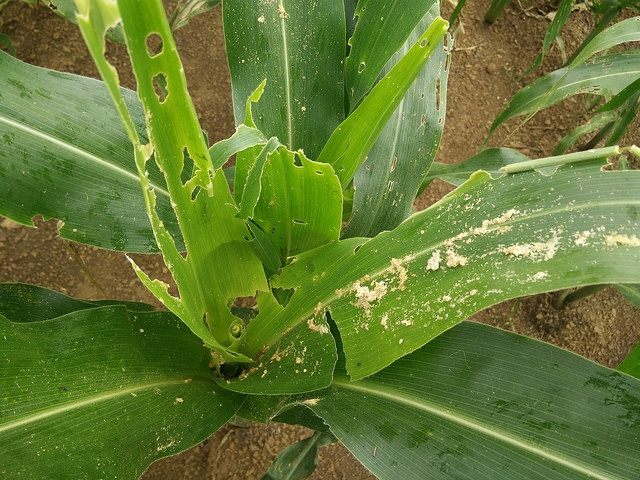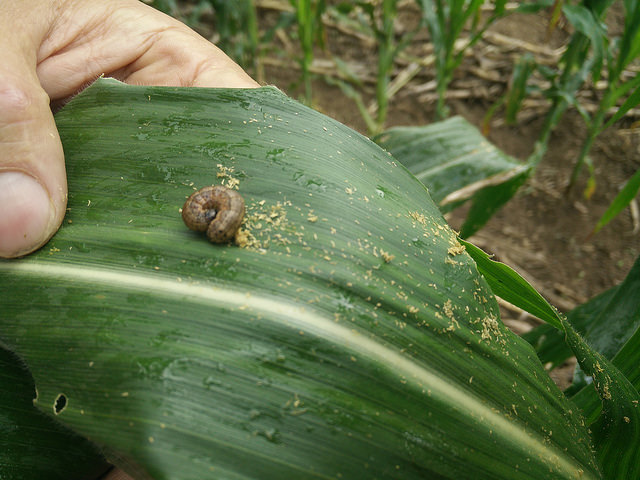Fall armyworm is one of the most destructive insect pests worldwide, and it is on the move. In 2015, this pest migrated for the first time to Nigeria. As of today, its devastation has been reported in 30 countries in Africa.
Estimates in September 2017 showed that just in six African countries, the pest has devastated almost 1.5 million hectares of maize crops. Without proper management, over the next one to two years, fall armyworm is expected to cause up to six billion dollars worth of damage across affected maize growing regions in sub-Saharan Africa.
Why is it such a majorly concerning pest? The first, most important reason is that fall armyworm is very highly poliphagus – which means the pest can attack not just one or two crops, but as many as 80 different plant species. Second, it can migrate very fast. Each moth population can travel up to 1,500 km.

Fall armyworm attacking crops in Zimbabwe. Photo credit: CIMMYT/M. Shindler
In case of America, where fall armyworm has been present but under control, it usually migrates to warmer weather in the winter. But in Africa, the weather conditions are quite conducive for the pest to remain in certain countries for a long time. This means fall armyworm is here to stay in sub-Saharan Africa. So we need to know how to adopt from various practices that have been followed elsewhere, tailor them to African agro-ecologies and sustainably manage the pest.
Raising farmer awareness on effective pesticide use and cultural control
The first, most important action that must be taken, is to raise awareness among farming communities on how to make wise decisions on application of pesticides. It is critical to apply the right kind of pesticide, at the right stage. This is when the larvae is within the first three of its six stages of development – in the final three stages larvae have become very big, and can protect themselves from coming into contact with the pesticide.
We must also create awareness amongst extension agents and the farming communities on what exactly this pest is, how not to panic, how to recognize the early stages during the early crop growth, and apply the right types of pesticides.
There are also certain cultural control efforts which need to be validated and quickly disseminated. For example – each larvae lays as many as 1000 to 1500 eggs each month, and these are laid in batches of around 200-300 eggs. These could be very easily recognized even with the naked eye on the leaves. If a farmer is trained to understand how to recognize those egg masses, then destroying them means you are destroying 300 potential larvae. So understanding what these egg masses look like, and quickly collecting and destroying them will be key.
Stepping up research on control measures and host plant resistance
The second most important aspect is to urgently carry out strategic research on control measures, such as biological control options. For example, there are many pesticides derived from naturally occuring bacterias and viruses that could be helpful, such as Basilothrongulences pesticides, Neem based bio pesticides, as well as egg and larvae paracetoids that are known to be very effective against fall armyworm outside Africa. So the capacity to quickly validate these options, to scale them up and release them is an extremely important action.
In a more long-term approach, institutions like CIMMYT are also intensively working on host plant resistance. Making use of historic research, we are now extensively testing maize and wheat varieties against the fall armyworm populations in Africa and we have got some very promising sources of resistance which we will be validating very soon.
But this will not be immediately available, the seeds for resistant varieties need to be identified, validated, and then systematically seed needs to be scaled up and deployed. But we must remember, this pest is unfortunately here to stay for decades. So we are running a marathon here, not a 100 meter sprint. We must conserve our energy to ensure we reach the finish line, employing both short and long-term solutions.

Fall armyworm found on crops in Zimbabwe. Photo credit: CIMMYT/M. Shindler
A manual for action
CIMMYT, in partnership with USAID and a number of research and development partners, national and international partners is working to produce a comprehensive manual on fall armyworm pest management in Africa. It will focus on six topics: how to apply integrated pest management to fall armyworm management; fall armyworm monitoring and surveillance; cultural control and sustainable agro-ecological approaches for fall armyworm management; biological control options; host plant resistance and sustainable pesticide use. The manual will be available in January.
There is a tremendous coordination effort at the local, regional and continental level that is required in the years to come in order to make these things happen.
This pest is not to be treated as some localized problem, because of its rapidly migrating capacity. So monitoring and surveillance methods across the continent need to be intensified, we need to take advantage of digital tools or applications for the farmers to actively send messages about the pest in different parts of the countries or provinces, and how best to communicate with them about control measures. We must also urgently plug research gaps that examine the efficacy of certain interventions, and also ensure the best pesticides are registered and available for use across all countries.
All these things mean there has to be a very strong investment in research and development and in active outreach program and coordinated networking. I estimate that it could cost in the next four to five years no less than 200-300 million dollars per year.
CIMMYT is ready to stand with others; IITA, ICIPE, CABI, national programs, and the private sector, to beat this pest – with a unified and systematic approach, it can be done.



